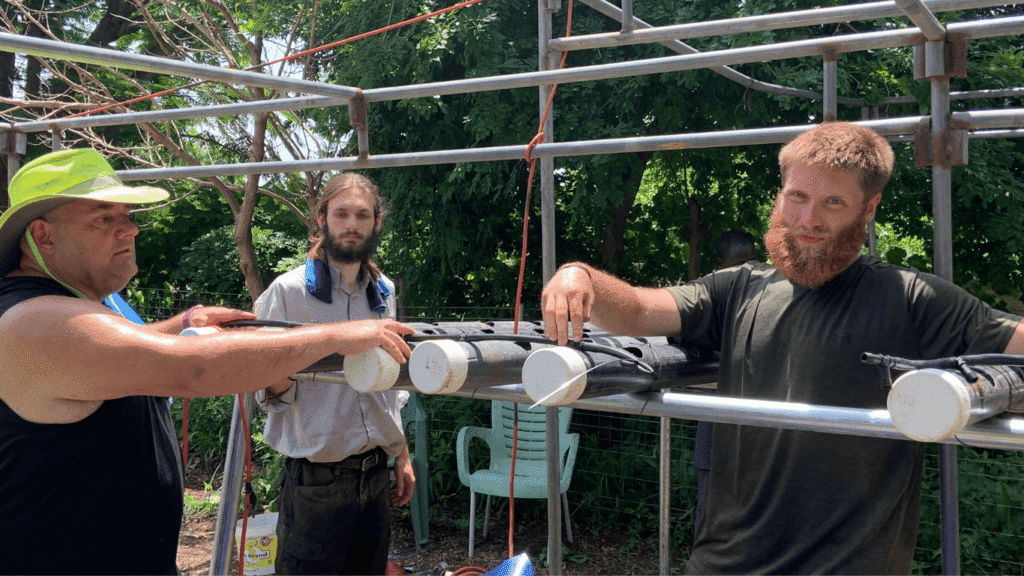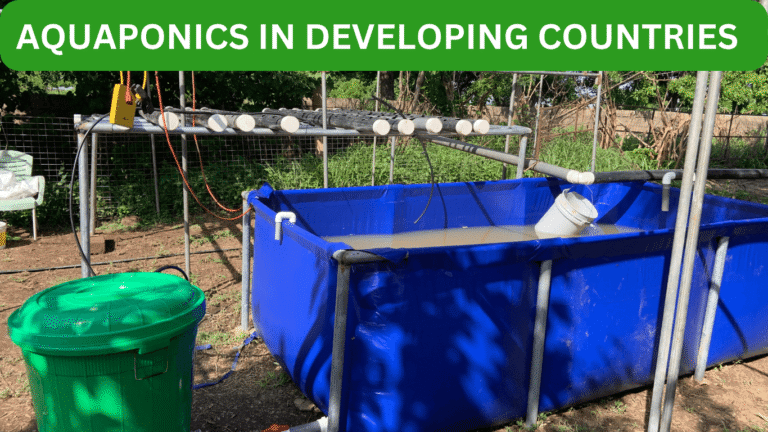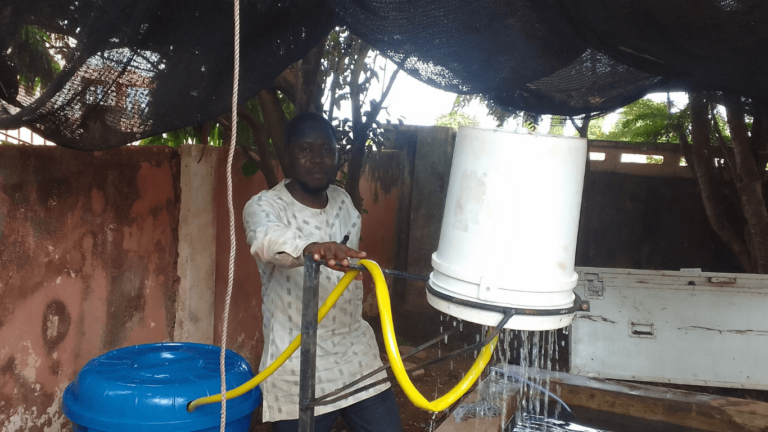In an era where global food insecurity affects over 828 million people worldwide, developing countries are turning to innovative agricultural solutions to address hunger, poverty, and environmental challenges. Aquaponics in developing countries has emerged as a game-changing technology that combines fish farming with soilless crop production, offering sustainable food systems that can thrive even in resource-constrained environments.
This comprehensive guide explores how aquaponics is revolutionizing agriculture across developing nations, from small-scale backyard systems to commercial ventures that are transforming entire communities.
What is Aquaponics?
Aquaponics is a sustainable farming method that combines aquaculture (fish farming) with hydroponics (soilless plant cultivation) in a symbiotic system. Fish waste provides natural fertilizer for plants, while plants filter and clean the water for fish, creating a closed-loop ecosystem that maximizes resource efficiency.
Why Does Aquaponics Matter for Developing Countries?
For developing countries facing challenges like poor soil quality, water scarcity, and limited arable land, aquaponics offers a revolutionary alternative to traditional farming methods.
This sustainable agriculture technique can produce both protein and vegetables simultaneously, making it particularly valuable in regions where malnutrition is prevalent.
Advantages of Aquaponics for Developing Nations
1. Water Conservation in Water-Scarce Regions
Traditional agriculture consumes approximately 70% of global freshwater resources, a luxury many developing countries cannot afford. Aquaponics systems use 90% less water than conventional farming methods through the Recirculating Aquaculture System (RAS) and minimal evaporation losses.
In countries like Kenya, Ethiopia, and parts of India, where water scarcity is a critical issue, aquaponics enables year-round food production with minimal water input. The closed-loop system ensures that water is continuously recycled, making it an ideal solution for arid and semi-arid regions.
2. Food Security Through Dual Production
One of the most compelling benefits of aquaponics for food security is its ability to produce both animal protein and fresh vegetables simultaneously.
In developing countries where protein deficiency is common, this dual production system addresses multiple nutritional needs with a single investment.
For example, a small aquaponics system can produce:
– Fresh fish (tilapia, catfish, or local species) providing essential proteins and omega-3 fatty acids
– Leafy greens, herbs, and vegetables rich in vitamins and minerals
– Continuous harvests throughout the year, regardless of seasonal variations
3. Independence from Soil Quality
Many developing countries struggle with soil degradation, erosion, and contamination from industrial activities. Soilless farming systems like aquaponics eliminate dependence on soil quality, allowing food production in areas previously considered unsuitable for agriculture.
Urban areas in developing countries, where soil contamination is often severe, can benefit tremendously from aquaponics. Rooftop systems, abandoned lots, and small urban spaces can be transformed into productive food-growing areas.
Success Stories: Aquaponics Transforming Communities
Ghana’s Urban Aquaponics Revolution
In Ghana, small-scale aquaponics systems are helping urban families achieve food security while generating income. Community-based projects in Accra and Kumasi have demonstrated how low-cost aquaponics systems can be built using locally available materials.
Even at Faako Aquaponics, we have also helped train and establish small aquaponics farms in the Northern Region, Tamale. And also at the Savanna Region, Buipe.
These systems typically cost between $500-1000 to establish and can produce enough vegetables and fish to feed a family of six while generating surplus for local markets. The success has led to government support and NGO partnerships to scale these initiatives across West Africa.

Faako Aquaponics Trained Team Expansion members in Savanna Region of Ghana
Kenya’s Innovative Approaches to Aquaponics
Kenya has become a leader in aquaponics in Africa, with farmers adapting the technology to local conditions and crop preferences. The integration of indigenous fish species like catfish with traditional vegetables such as kale and spinach has created culturally appropriate food systems that communities readily accept.
Bangladesh’s Climate-Resilient Farming
In flood-prone areas of Bangladesh, floating aquaponics systems have provided climate-resilient food production alternatives. These innovative systems can withstand seasonal flooding while continuing to produce food, offering hope for communities regularly affected by extreme weather events.
How To Set Up Aquaponics Systems in Resource-Constrained Environments
Low-Cost System Design
Building aquaponics in developing countries on a low budget requires creativity and local resource utilization. Successful systems in developing countries often use:
– Repurposed containers (old bathtubs, plastic drums, IBC totes)
– Local construction materials (bamboo, locally-made PVC pipes)
– Solar-powered pumps for areas with unreliable electricity
– Gravity-fed systems that require no electricity
How To Choose Appropriate Fish Species for Aquaponics
Fish selection for aquaponics in developing countries should consider local climate, water conditions, and market preferences. Popular choices in developing countries include:
– Tilapia: Hardy, fast-growing, and adaptable to various water conditions
– Catfish: Tolerant of poor water quality and popular in many local markets
– Carp: Cold-tolerant option suitable for highland regions
– Indigenous species: Often better adapted to local conditions and have established markets
How to Select Plants for Aquaponics in Developing Countries
Vegetable crops for aquaponics in developing countries should focus on:
– High-nutrition, fast-growing leafy greens (spinach, lettuce, kale)
– Culturally important vegetables that families already consume
– High-value crops that can generate income (herbs, specialty vegetables)
– Plants that are adapted to local climate conditions
Economic Impact of Aquaponics in Developing Countries
Micro-Enterprise Opportunities
Aquaponics as a business in developing countries offers numerous income-generating opportunities:
– Direct sales of fresh fish and vegetables to local markets
– Value-added products (dried fish, processed vegetables)
– Training and consultation services for other farmers
– Agritourism and educational programs
Cost-Benefit Analysis
Initial investment in small-scale aquaponics systems typically ranges from $500-1000, depending on size and complexity. Return on investment usually occurs within 6-12 months through:
– Reduced food expenses for families
– Income from surplus production
– Savings on transportation and storage costs
– Year-round production stability
Market Development
Successful aquaponics commercialization requires understanding local market dynamics, building relationships with buyers, and ensuring consistent quality. Many developing countries have growing urban populations seeking fresh, locally-produced food, creating ready markets for aquaponics products.
Challenges of Aquaponics in Developing Countries
Technical Challenges
Common aquaponics problems in developing countries include:
– Limited access to technical knowledge and training
– Inconsistent electricity supply for pumps and aeration
– Difficulty sourcing quality fish feed and seeds
– Water quality management without expensive testing equipment
Solutions to Aquaponics Challenges in Developing Countries
– Community-based training programs and knowledge sharing
– Solar-powered and gravity-fed system designs
– Local feed production using agricultural waste
– Simple, low-cost water testing methods
Economic Barriers of Aquaponics in Developing Nations
– High initial setup costs relative to local income levels
– Limited access to credit and financing
– Competition from subsidized conventional agriculture
– Lack of government support and recognition
Social and Cultural Factors of Aquaponics Developing Countries
– Resistance to new technologies
– Lack of awareness about aquaponics benefits
– Cultural food preferences and eating habits
– Gender-related barriers to technology adoption
Government Support and Policy Framework of Aquaponics
Successful Policy Models
Countries like Rwanda and Uganda have integrated aquaponics into their national food security strategies, providing:
– Technical training through agricultural extension services
– Subsidies for system components and setup costs
– Research and development support through universities
– Market linkage programs connecting farmers with buyers
International Development Support
Organizations like FAO, USAID, and various NGOs have recognized aquaponics potential for sustainable development goals, supporting projects that:
– Improve food and nutrition security
– Promote climate-smart agriculture
– Enhance rural livelihoods and income generation
– Build resilient food systems
Technology Adaptation and Innovation in Aquaponics
Mobile Technology Integration
Smart aquaponics solutions are being adapted for developing country contexts:
– SMS-based monitoring and alert systems
– Mobile apps for system management and market connections
– Solar-powered sensors for basic system monitoring
– WhatsApp groups for farmer knowledge sharing
Local Innovation of Aquaponics
Farmers in developing countries are creating innovative solutions:
– Biogas integration for heating and electricity generation
– Waste-to-feed conversion systems
– Climate-adaptive greenhouse designs using local materials
– Community-shared larger systems to reduce individual costs
Climate Change Resilience
Adaptation Benefits
Climate-smart aquaponics helps developing countries adapt to climate change through:
– Reduced vulnerability to droughts and floods
– Year-round production despite irregular rainfall
– Lower greenhouse gas emissions compared to traditional farming
– Resilient food systems that can withstand extreme weather
Environmental Benefits of Aquaponics
Aquaponics contributes to environmental sustainability by:
– Reducing agricultural runoff and water pollution
– Minimizing pesticide and fertilizer use
– Conserving natural ecosystems and biodiversity
– Supporting circular economy principles
Training and Capacity Building
Educational Programs
Successful aquaponics education initiatives in developing countries include:
– Hands-on training workshops for farmers
– School-based programs teaching sustainable agriculture
– Women’s cooperative training for economic empowerment
– Youth entrepreneurship programs in rural areas
Knowledge Transfer
Effective knowledge transfer requires:
– Training materials in local languages
– Practical, hands-on learning approaches
– Peer-to-peer learning networks
– Ongoing technical support and mentorship
Future Prospects and Scaling Opportunities
Market Growth Potential
The aquaponics market in developing countries is projected to grow significantly due to:
– Increasing urban populations demanding fresh food
– Growing awareness of sustainable agriculture benefits
– Government support for food security initiatives
– International development funding for innovative agriculture
Technology Evolution of Aquaponics
Emerging technologies will make aquaponics more accessible:
– Lower-cost system components and automation
– Improved fish feeds and plant nutrients designed for local conditions
– Better water quality management tools
– Enhanced monitoring and control systems
Conclusion: Building Resilient Food Systems for the Future
Aquaponics represents a transformative opportunity for developing countries to address food security, economic development, and environmental sustainability simultaneously. As climate change intensifies and urban populations grow, this innovative farming method offers a practical, scalable solution that can be adapted to diverse local conditions and resource constraints.
The success stories from across Africa, Asia, and Latin America demonstrate that with proper support, training, and community engagement, aquaponics in developing countries can become a cornerstone of sustainable food systems.
By combining traditional knowledge with modern technology, developing nations can build resilient agricultural systems that provide food security, economic opportunities, and environmental benefits for current and future generations.
For farmers, entrepreneurs, and development organizations looking to implement aquaponics projects, the key lies in starting small, learning from local conditions, and building strong community partnerships. With continued innovation and support, aquaponics will play an increasingly important role in creating food-secure, sustainable communities across the developing world.




